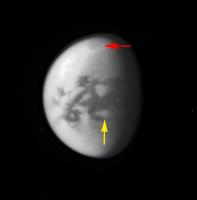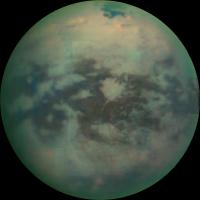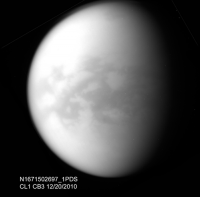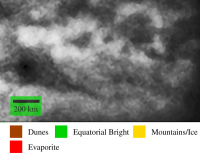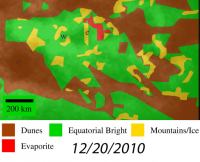Printable Version of Topic
Click here to view this topic in its original format
Unmanned Spaceflight.com _ Titan _ Rev 160 Titan monitoring
Posted by: titanicrivers Jan 25 2012, 09:23 AM
Rev 160 http://www.ciclops.org/view/7051/Rev160 view of Senkyo region appears to be showing less bright spot albedo change (yellow arrow) than 2 months ago. Image is from quite a distance however (3.2M km). Kraken in the north (red arrow) appears to have a brighter rim surrounding the darker sea, perhaps an artifact of my image processing. edit: sorry for the typo in the topic description! (fixed - Mod)
Posted by: ngunn Jan 25 2012, 10:13 AM
I'm pretty sure the relatively bright 'halo' around Kraken Mare is real. Certainly it has been discussed before. I think Juramike had some ideas. I also think it's been mentioned in the literature. (Sorry I don't have references handy.) Anyhow it would be interesting to have people's latest thoughts on this.
Posted by: Jason W Barnes Jan 29 2012, 05:47 AM
Ring around Kraken isn't in the literature yet. VIMS T67 attached. Its spectrum, location, and morphology are consistent with evaporite.
- Jason
Posted by: ngunn Jan 29 2012, 07:57 AM
Very interesting! That great image clearly shows the bright halo is most prominent at the heads of the southern bays whereas the capes between are relatively halo-free. Oh for some radar coverage of those bays to confirm that their shores are indeed smoother and more gently shelving.
Posted by: titanicrivers Jan 29 2012, 08:19 AM
Yes fascinating. Kraken and its evaporative ring (black arrow) have been relatively stable over the 2010-11 period at least in ISS images (see below). The ISS ring appears more uniform and continuous around Kraken. Are the very bright portions of the VIMS image evaporite or clouds hugging the shoreline???
That small Senkyo area affected by the arrow storm (red arrow) went from a dark patch to a bright spot over the Dec 2010 to Sept 2011 time period. I would presume this might be an evaporite as well. Jason, is there a post-arrow storm image VIMS image of Senkyo covering the same area as that neat April 2010 pre-storm image you have posted above ?
Posted by: Juramike Jan 29 2012, 08:11 PM
(...keeping quiet until the LPSC abstracts publish on Friday...)
Posted by: Jason W Barnes Feb 3 2012, 10:06 PM
I note that based on your arrow this change appears not occur within Senkyo, but rather within the newly named http://astrogeology.usgs.gov/HotTopics/index.php?/archives/438-Names-Approved-for-Three-Terrae-and-Two-Regiones-on-Titan.html.
- Jason
Posted by: ngunn Feb 3 2012, 10:34 PM
Is this the absract that relates to this discussion?
http://www.lpi.usra.edu/meetings/lpsc2012/pdf/2762.pdf
Posted by: titanicrivers Feb 4 2012, 12:49 AM
"I note that based on your arrow this change appears not occur within Senkyo, but rather within the newly named Yalaing Terra."
- Jason
Thanks for the proper name! Yes Yalaing Terra is what I had been referring to as Senkyo or South of Senkyo or S Senkyo since noting the change in December of 2010. http://www.unmannedspaceflight.com/index.php?showtopic=6829 The center of this region became a dark albedo post arrow-storm that gradually brightened and persisted as bright throughout most of 2011 (now fading a bit towards its pre-arrow storm albedo). The grid I made last year matches the official IAU coordinates of Yalaing Terra. The link below shows the projected position of the ‘arrow-storm’ directly over this terra!
http://www.unmannedspaceflight.com/index.php?act=attach&type=post&id=23524
The change over the last year has been interesting to follow:
http://www.unmannedspaceflight.com/index.php?act=attach&type=post&id=26004
and now its interesting to read of the possible mechanisms of such changes in your LPSC abstract Nigel has highlighted above!
Posted by: Jason W Barnes Feb 8 2012, 07:37 PM
http://www.lpi.usra.edu/meetings/lpsc2012/pdf/2762.pdf
Yup. I note that these days the IAU only likes to name areas that require names in order to be referred to in a peer-reviewed scientific paper.
- Jason
Posted by: Jason W Barnes Nov 7 2013, 10:43 PM
BTW, the joint VIMS/ISS http://www.planetary-science.com/content/2/1/1 is out in the new Open Access journal Planetary Science.
- VIMS Jason
Posted by: titanicrivers Nov 9 2013, 03:41 AM
Thanks Jason for the link to your paper, a very readable and comprehensive analysis of the surface changes of specific regions affected by the massive ‘arrow storm’ of Sept 2010. The discussion of the VIMS versus ISS imaging changes and the constraints the observations place on what the storm most likely did to Titan’s surface are outstanding.
My favorite region analyzed was (of course) Yalaing Terra. Borrowing Fig2 from the paper and using the tiff file PDS version of the Dec 20 2010 image showing the earliest changes in the area, one is struck how the larger and moderately darkened central area seems to nestle nicely into the geography perhaps suggesting some ponding/playa formation.
Posted by: Jason W Barnes Nov 13 2013, 04:38 AM
Nice! It's too bad you can't put an animated .gif like that into a paper. Especially in this kind of case with changes it would just be WAY easier to understand than a bunch of pictures thrown together like I ended up having to do
- VIMS Jason
Posted by: titanicrivers Nov 24 2013, 10:31 PM
The PDS version of the jpeg raw image N00175714 is incorporated in the figure below. That image taken in Sep 2011 showed the remarkable transformation of central Yalaing terra from ISS dark to ISS bright . Once again the geographic map and geomorphology units are from Fig 2 of the Barnes et al paper cited above.
Powered by Invision Power Board (http://www.invisionboard.com)
© Invision Power Services (http://www.invisionpower.com)
